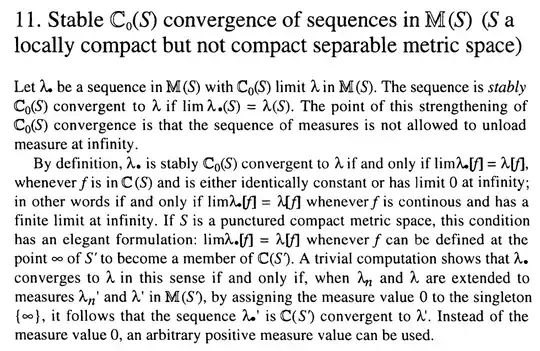Below are paragraphs I took from Doob's Measure Theory.
A function $f$ from a metric space $S$ into a metric space is said to have limit $\alpha$ at infinity if the inverse image of each neighborhood of $\alpha$ is contained in the complement of a compact subset of $S$. Let
- $S$ be a metric space,
- $\mathbb M(S)$ the space of all finite signed Borel measures on $S$,
- $\mathbb C(S)$ be the space of real-valued bounded continuous functions on $S$,
- $\mathbb C_0(S)$ be the space of real-valued continuous functions on $S$ with limit $0$ at infinity, and
- $\mathbb C_{00} (S)$ the space of real-valued continuous functions on $S$ with compact supports.
For $E \in \{\mathbb C(S), \mathbb C_0(S), \mathbb C_{00} (S)\}$, a sequence $\lambda_{ \bullet} \subset \mathbb{M}(S)$ is said to be $E$-convergent to $\lambda \in \mathbb{M}(S)$ if $\lim \lambda_{ \bullet}[f]=\lambda[f]$ for all $f$ in $E$.
Let $\lambda_{ \bullet}$ be a sequence in $\mathbb{M}(S)$ with $\mathbb{C}_0(S)$-limit $\lambda$ in $\mathbb{M}(S)$. The sequence is stably $\mathbb{C}_0(S)$-convergent to $\lambda$ if $\lim \lambda_{\bullet}(S)=\lambda(S)$. The point of this strengthening of $\mathbb{C}_0(S)$-convergence is that the sequence of measures is not allowed to unload measure at infinity.
By definition, $\lambda_{ \bullet}$ is stably $\mathbb{C}_0(S)$-convergent to $\lambda$ if and only if $\lim \lambda_{ \bullet}[f]=\lambda[f]$, whenever $f$ is in $\mathbb{C}(S)$ and is either identically constant or has limit $0$ at infinity; in other words if and only if $\lim \lambda_{ \bullet}[f]=\lambda[f]$ whenever $f$ is continuous and has a finite limit at infinity.
My understanding: It seems the author's definition of a function with limit $0$ at infinity coincides with the usual one. It seems from above that the following statements are equivalent, i.e.,
- $\lim \lambda_{ \bullet}[f]=\lambda[f]$ for all $f \in \mathbb{C}_0(S)$ and $\lim \lambda_{\bullet}(S)=\lambda(S)$.
- $\lim \lambda_{ \bullet}[f]=\lambda[f]$ for all $f \in \mathbb{C}(S)$ that is either constant or has limit $0$ at infinity.
- $\lim \lambda_{ \bullet}[f]=\lambda[f]$ for all continuous $f$ that is either constant or has a finite limit at infinity.
I understand how 2. is equivalent to 1. and how 3. implies 1.
Could you explain how 1. implies 3.?
Update: I think I was wrong in claiming that "the author's definition of a function with limit $0$ at infinity coincides with the usual one". Let $\alpha=0$ and $\varepsilon>0$. Then $(-\varepsilon, \varepsilon)$ is a neighborhood of $\alpha$.
In author's sense: there is a compact subset $K$ of $S$ such that $f^{-1}((-\varepsilon, \varepsilon)) \subset K^c$. This is equivalent to $|f(x)| < \varepsilon \implies x \in K^c$.
In the usual sense: there is a compact subset $K$ of $S$ such that $|f(x)| < \varepsilon$ for all $x \in K^c$. This is equivalent to $|f(x)| \ge \varepsilon \implies x \in K$.
For a reference, I attach below a screenshot from the book.
